ESP Seat Altea Freetrack 2012 Owner's Manual
[x] Cancel search | Manufacturer: SEAT, Model Year: 2012, Model line: Altea Freetrack, Model: Seat Altea Freetrack 2012Pages: 297, PDF Size: 4.31 MB
Page 3 of 297
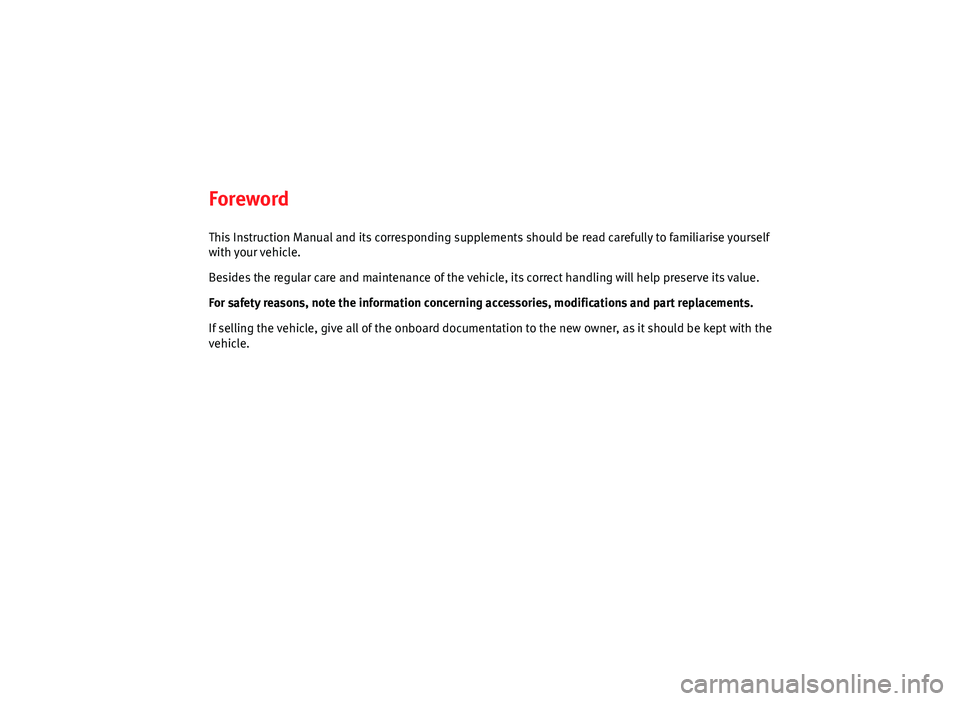
Foreword
This Instruction Manual and its corresponding supplements should be read carefully to familiarise yourself
with your vehicle.
Besides the regular care and maintenance of the vehicle, its correct handling will help preserve its value.
For safety reasons, note the information concerning accessories, modifications and part replacements.
If selling the vehicle, give all of the onboard documentation to the new owner, as it should be kept with the
vehicle.
Page 5 of 297
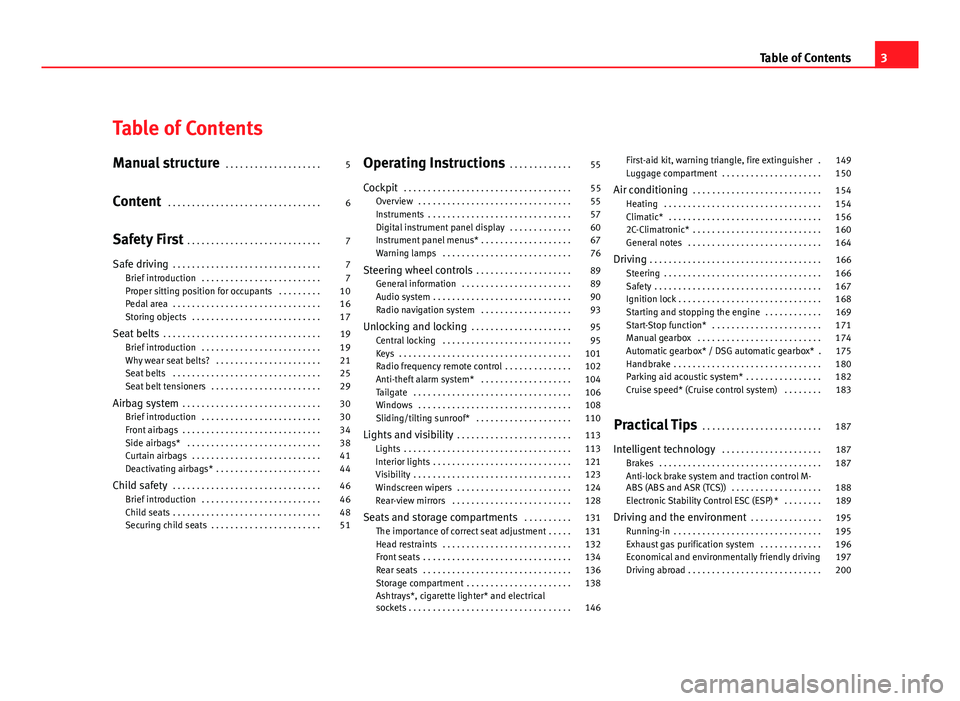
Table of Contents
Manual structure . . . . . . . . . . . . . . . . . . . . 5
Content . . . . . . . . . . . . . . . . . . . . . . . . . . . . . . . . 6
Safety First . . . . . . . . . . . . . . . . . . . . . . . . . . . . 7
Safe driving . . . . . . . . . . . . . . . . . . . . . . . . . . . . . . . 7
Brief introduction . . . . . . . . . . . . . . . . . . . . . . . . . 7
Proper sitting position for occupants . . . . . . . . . 10
Pedal area . . . . . . . . . . . . . . . . . . . . . . . . . . . . . . . 16
Storing objects . . . . . . . . . . . . . . . . . . . . . . . . . . . 17
Seat belts . . . . . . . . . . . . . . . . . . . . . . . . . . . . . . . . . 19
Brief introduction . . . . . . . . . . . . . . . . . . . . . . . . . 19
Why wear seat belts? . . . . . . . . . . . . . . . . . . . . . . 21
Seat belts . . . . . . . . . . . . . . . . . . . . . . . . . . . . . . . 25
Seat belt tensioners . . . . . . . . . . . . . . . . . . . . . . . 29
Airbag system . . . . . . . . . . . . . . . . . . . . . . . . . . . . . 30
Brief introduction . . . . . . . . . . . . . . . . . . . . . . . . . 30
Front airbags . . . . . . . . . . . . . . . . . . . . . . . . . . . . . 34
Side airbags* . . . . . . . . . . . . . . . . . . . . . . . . . . . . 38
Curtain airbags . . . . . . . . . . . . . . . . . . . . . . . . . . . 41
Deactivating airbags* . . . . . . . . . . . . . . . . . . . . . . 44
Child safety . . . . . . . . . . . . . . . . . . . . . . . . . . . . . . . 46
Brief introduction . . . . . . . . . . . . . . . . . . . . . . . . . 46
Child seats . . . . . . . . . . . . . . . . . . . . . . . . . . . . . . . 48
Securing child seats . . . . . . . . . . . . . . . . . . . . . . . 51 Operating Instructions
. . . . . . . . . . . . . 55
Cockpit . . . . . . . . . . . . . . . . . . . . . . . . . . . . . . . . . . . 55
Overview . . . . . . . . . . . . . . . . . . . . . . . . . . . . . . . . 55
Instruments . . . . . . . . . . . . . . . . . . . . . . . . . . . . . . 57
Digital instrument panel display . . . . . . . . . . . . . 60
Instrument panel menus* . . . . . . . . . . . . . . . . . . . 67
Warning lamps . . . . . . . . . . . . . . . . . . . . . . . . . . . 76
Steering wheel controls . . . . . . . . . . . . . . . . . . . . 89
General information . . . . . . . . . . . . . . . . . . . . . . . 89
Audio system . . . . . . . . . . . . . . . . . . . . . . . . . . . . . 90
Radio navigation system . . . . . . . . . . . . . . . . . . . 93
Unlocking and locking . . . . . . . . . . . . . . . . . . . . . 95
Central locking . . . . . . . . . . . . . . . . . . . . . . . . . . . 95
Keys . . . . . . . . . . . . . . . . . . . . . . . . . . . . . . . . . . . . 101
Radio frequency remote control . . . . . . . . . . . . . . 102
Anti-theft alarm system* . . . . . . . . . . . . . . . . . . . 104
Tailgate . . . . . . . . . . . . . . . . . . . . . . . . . . . . . . . . . 106
Windows . . . . . . . . . . . . . . . . . . . . . . . . . . . . . . . . 108
Sliding/tilting sunroof* . . . . . . . . . . . . . . . . . . . . 110
Lights and visibility . . . . . . . . . . . . . . . . . . . . . . . . 113
Lights . . . . . . . . . . . . . . . . . . . . . . . . . . . . . . . . . . . 113
Interior lights . . . . . . . . . . . . . . . . . . . . . . . . . . . . . 121
Visibility . . . . . . . . . . . . . . . . . . . . . . . . . . . . . . . . . 123
Windscreen wipers . . . . . . . . . . . . . . . . . . . . . . . . 124
Rear-view mirrors . . . . . . . . . . . . . . . . . . . . . . . . . 128
Seats and storage compartments . . . . . . . . . . 131
The importance of correct seat adjustment . . . . . 131
Head restraints . . . . . . . . . . . . . . . . . . . . . . . . . . . 132
Front seats . . . . . . . . . . . . . . . . . . . . . . . . . . . . . . . 134
Rear seats . . . . . . . . . . . . . . . . . . . . . . . . . . . . . . . 136
Storage compartment . . . . . . . . . . . . . . . . . . . . . . 138
Ashtrays*, cigarette lighter* and electrical
sockets . . . . . . . . . . . . . . . . . . . . . . . . . . . . . . . . . . 146 First-aid kit, warning triangle, fire extinguisher . 149
Luggage compartment . . . . . . . . . . . . . . . . . . . . . 150
Air conditioning . . . . . . . . . . . . . . . . . . . . . . . . . . . 154
Heating . . . . . . . . . . . . . . . . . . . . . . . . . . . . . . . . . 154
Climatic* . . . . . . . . . . . . . . . . . . . . . . . . . . . . . . . . 156
2C-Climatronic* . . . . . . . . . . . . . . . . . . . . . . . . . . . 160
General notes . . . . . . . . . . . . . . . . . . . . . . . . . . . . 164
Driving . . . . . . . . . . . . . . . . . . . . . . . . . . . . . . . . . . . . 166
Steering . . . . . . . . . . . . . . . . . . . . . . . . . . . . . . . . . 166
Safety . . . . . . . . . . . . . . . . . . . . . . . . . . . . . . . . . . . 167
Ignition lock . . . . . . . . . . . . . . . . . . . . . . . . . . . . . . 168
Starting and stopping the engine . . . . . . . . . . . . 169
Start-Stop function* . . . . . . . . . . . . . . . . . . . . . . . 171
Manual gearbox . . . . . . . . . . . . . . . . . . . . . . . . . . 174
Automatic gearbox* / DSG automatic gearbox* . 175
Handbrake . . . . . . . . . . . . . . . . . . . . . . . . . . . . . . . 180
Parking aid acoustic system* . . . . . . . . . . . . . . . . 182
Cruise speed* (Cruise control system) . . . . . . . . 183
Practical Tips . . . . . . . . . . . . . . . . . . . . . . . . . 187
Intelligent technology . . . . . . . . . . . . . . . . . . . . . 187
Brakes . . . . . . . . . . . . . . . . . . . . . . . . . . . . . . . . . . 187
Anti-lock brake system and traction control M-
ABS (ABS and ASR (TCS)) . . . . . . . . . . . . . . . . . . . 188
Electronic Stability Control ESC (ESP) * . . . . . . . . 189
Driving and the environment . . . . . . . . . . . . . . . 195
Running-in . . . . . . . . . . . . . . . . . . . . . . . . . . . . . . . 195
Exhaust gas purification system . . . . . . . . . . . . . 196
Economical and environmentally friendly driving 197
Driving abroad . . . . . . . . . . . . . . . . . . . . . . . . . . . . 200
3
Table of Contents
Page 9 of 297
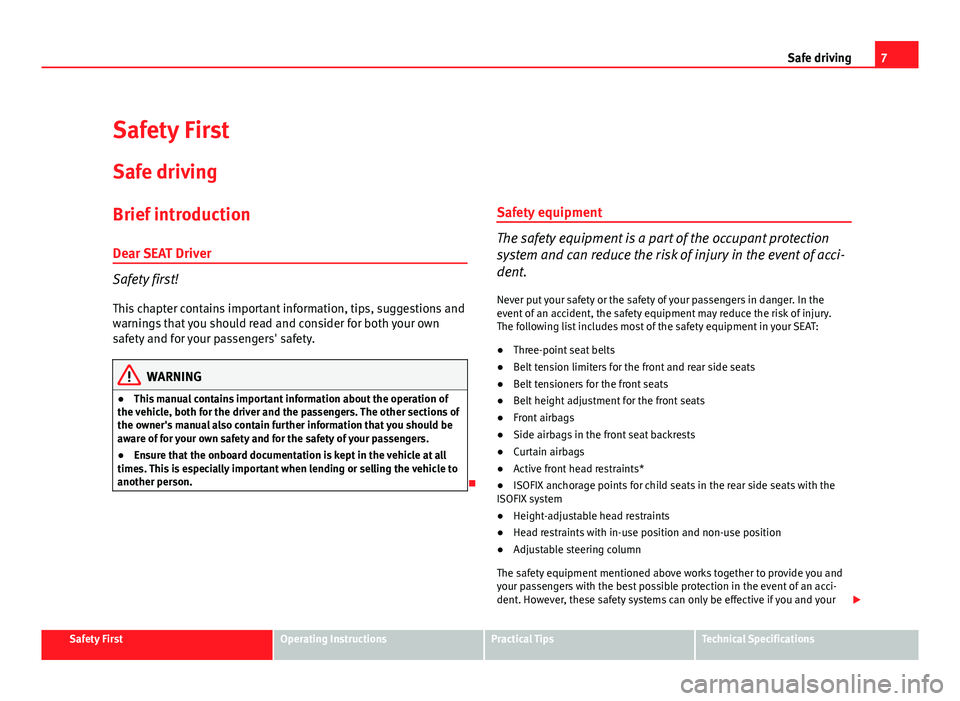
7
Safe driving
Safety First
Safe driving
Brief introduction
Dear SEAT Driver
Safety first! This chapter contains important information, tips, suggestions and
warnings that you should read and consider for both your own
safety and for your passengers' safety.
WARNING
● This manual contains important information about the operation of
the vehicle, both for the driver and the passengers. The other sections of
the owner's manual also contain further information that you should be
aware of for your own safety and for the safety of your passengers.
● Ensure that the onboard documentation is kept in the vehicle at all
times. This is especially important when lending or selling the vehicle to
another person.
Safety equipment
The safety equipment is a part of the occupant protection
system and can reduce the risk of injury in the event of acci-
dent.
Never put your safety or the safety of your passengers in danger. In the
event of an accident, the safety equipment may reduce the risk of injury.
The following list includes most of the safety equipment in your SEAT:
● Three-point seat belts
● Belt tension limiters for the front and rear side seats
● Belt tensioners for the front seats
● Belt height adjustment for the front seats
● Front airbags
● Side airbags in the front seat backrests
● Curtain airbags
● Active front head restraints*
● ISOFIX anchorage points for child seats in the rear side seats with the
ISOFIX system
● Height-adjustable head restraints
● Head restraints with in-use position and non-use position
● Adjustable steering column
The safety equipment mentioned above works together to provide you and
your passengers with the best possible protection in the event of an acci-
dent. However, these safety systems can only be effective if you and your
Safety FirstOperating InstructionsPractical TipsTechnical Specifications
Page 10 of 297
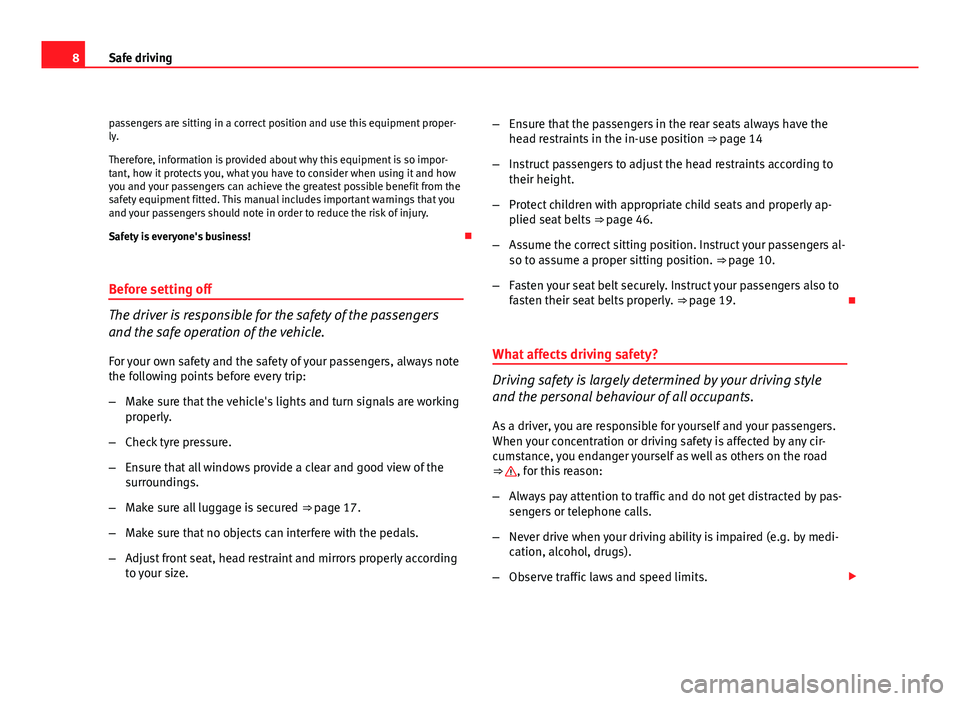
8Safe driving
passengers are sitting in a correct position and use this equipment proper-
ly.
Therefore, information is provided about why this equipment is so impor-
tant, how it protects you, what you have to consider when using it and how
you and your passengers can achieve the greatest possible benefit from the
safety equipment fitted. This manual includes important warnings that you
and your passengers should note in order to reduce the risk of injury.
Safety is everyone's business!
Before setting off
The driver is responsible for the safety of the passengers
and the safe operation of the vehicle.
For your own safety and the safety of your passengers, always note
the following points before every trip:
– Make sure that the vehicle's lights and turn signals are working
properly.
– Check tyre pressure.
– Ensure that all windows provide a clear and good view of the
surroundings.
– Make sure all luggage is secured ⇒ page 17.
– Make sure that no objects can interfere with the pedals.
– Adjust front seat, head restraint and mirrors properly according
to your size. –
Ensure that the passengers in the rear seats always have the
head restraints in the in-use position ⇒ page 14
– Instruct passengers to adjust the head restraints according to
their height.
– Protect children with appropriate child seats and properly ap-
plied seat belts ⇒ page 46.
– Assume the correct sitting position. Instruct your passengers al-
so to assume a proper sitting position. ⇒ page 10.
– Fasten your seat belt securely. Instruct your passengers also to
fasten their seat belts properly. ⇒ page 19.
What affects driving safety?
Driving safety is largely determined by your driving style
and the personal behaviour of all occupants. As a driver, you are responsible for yourself and your passengers.
When your concentration or driving safety is affected by any cir-
cumstance, you endanger yourself as well as others on the road
⇒
, for this reason:
– Always pay attention to traffic and do not get distracted by pas-
sengers or telephone calls.
– Never drive when your driving ability is impaired (e.g. by medi-
cation, alcohol, drugs).
– Observe traffic laws and speed limits.
Page 17 of 297
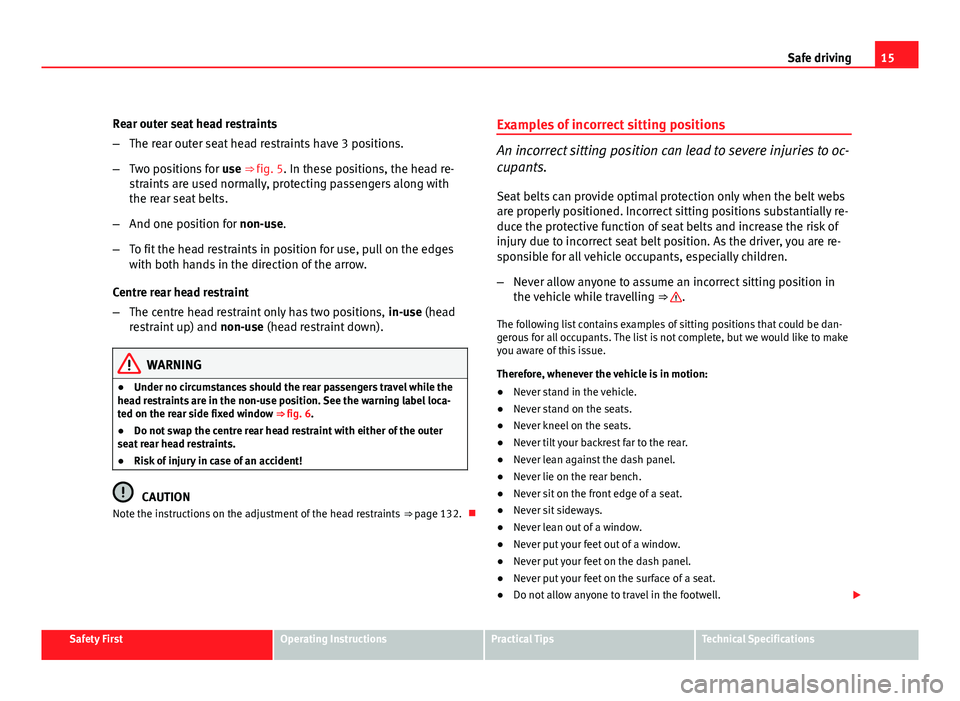
15
Safe driving
Rear outer seat head restraints
– The rear outer seat head restraints have 3 positions.
– Two positions for use ⇒ fig. 5. In these positions, the head re-
straints are used normally, protecting passengers along with
the rear seat belts.
– And one position for non-use.
– To fit the head restraints in position for use, pull on the edges
with both hands in the direction of the arrow.
Centre rear head restraint
– The centre head restraint only has two positions, in-use (head
restraint up) and non-use (head restraint down).
WARNING
● Under no circumstances should the rear passengers travel while the
head restraints are in the non-use position. See the warning label loca-
ted on the rear side fixed window ⇒ fig. 6.
● Do not swap the centre rear head restraint with either of the outer
seat rear head restraints.
● Risk of injury in case of an accident!
CAUTION
Note the instructions on the adjustment of the head restraints ⇒ page 132. Examples of incorrect sitting positions
An incorrect sitting position can lead to severe injuries to oc-
cupants.
Seat belts can provide optimal protection only when the belt webs
are properly positioned. Incorrect sitting positions substantially re-
duce the protective function of seat belts and increase the risk of
injury due to incorrect seat belt position. As the driver, you are re-
sponsible for all vehicle occupants, especially children.
– Never allow anyone to assume an incorrect sitting position in
the vehicle while travelling ⇒
.
The following list contains examples of sitting positions that could be dan-
gerous for all occupants. The list is not complete, but we would like to make
you aware of this issue.
Therefore, whenever the vehicle is in motion:
● Never stand in the vehicle.
● Never stand on the seats.
● Never kneel on the seats.
● Never tilt your backrest far to the rear.
● Never lean against the dash panel.
● Never lie on the rear bench.
● Never sit on the front edge of a seat.
● Never sit sideways.
● Never lean out of a window.
● Never put your feet out of a window.
● Never put your feet on the dash panel.
● Never put your feet on the surface of a seat.
● Do not allow anyone to travel in the footwell.
Safety FirstOperating InstructionsPractical TipsTechnical Specifications
Page 19 of 297
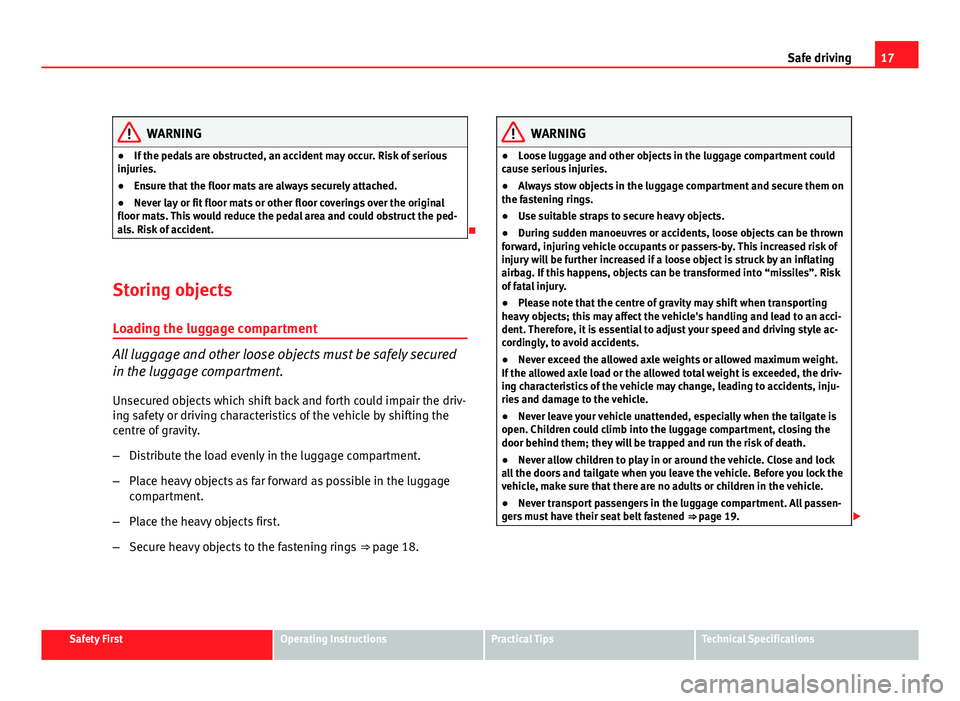
17
Safe driving
WARNING
● If the pedals are obstructed, an accident may occur. Risk of serious
injuries.
● Ensure that the floor mats are always securely attached.
● Never lay or fit floor mats or other floor coverings over the original
floor mats. This would reduce the pedal area and could obstruct the ped-
als. Risk of accident.
Storing objects Loading the luggage compartment
All luggage and other loose objects must be safely secured
in the luggage compartment.
Unsecured objects which shift back and forth could impair the driv-
ing safety or driving characteristics of the vehicle by shifting the
centre of gravity.
– Distribute the load evenly in the luggage compartment.
– Place heavy objects as far forward as possible in the luggage
compartment.
– Place the heavy objects first.
– Secure heavy objects to the fastening rings ⇒ page 18.
WARNING
● Loose luggage and other objects in the luggage compartment could
cause serious injuries.
● Always stow objects in the luggage compartment and secure them on
the fastening rings.
● Use suitable straps to secure heavy objects.
● During sudden manoeuvres or accidents, loose objects can be thrown
forward, injuring vehicle occupants or passers-by. This increased risk of
injury will be further increased if a loose object is struck by an inflating
airbag. If this happens, objects can be transformed into “missiles”. Risk
of fatal injury.
● Please note that the centre of gravity may shift when transporting
heavy objects; this may affect the vehicle's handling and lead to an acci-
dent. Therefore, it is essential to adjust your speed and driving style ac-
cordingly, to avoid accidents.
● Never exceed the allowed axle weights or allowed maximum weight.
If the allowed axle load or the allowed total weight is exceeded, the driv-
ing characteristics of the vehicle may change, leading to accidents, inju-
ries and damage to the vehicle.
● Never leave your vehicle unattended, especially when the tailgate is
open. Children could climb into the luggage compartment, closing the
door behind them; they will be trapped and run the risk of death.
● Never allow children to play in or around the vehicle. Close and lock
all the doors and tailgate when you leave the vehicle. Before you lock the
vehicle, make sure that there are no adults or children in the vehicle.
● Never transport passengers in the luggage compartment. All passen-
gers must have their seat belt fastened ⇒ page 19.
Safety FirstOperating InstructionsPractical TipsTechnical Specifications
Page 20 of 297
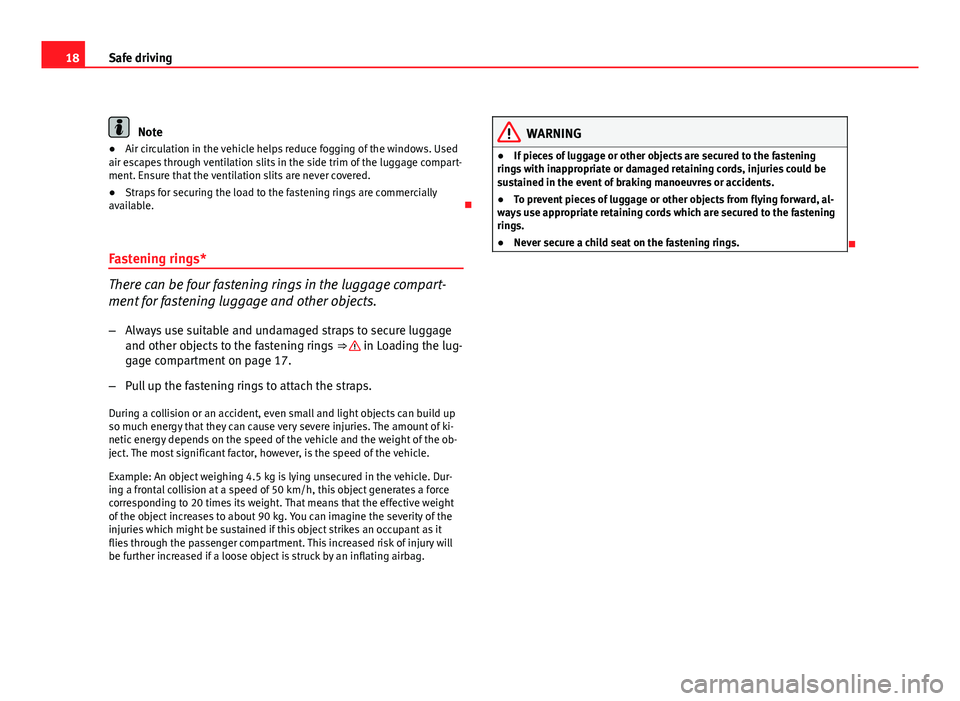
18Safe driving
Note
● Air circulation in the vehicle helps reduce fogging of the windows. Used
air escapes through ventilation slits in the side trim of the luggage compart-
ment. Ensure that the ventilation slits are never covered.
● Straps for securing the load to the fastening rings are commercially
available.
Fastening rings*
There can be four fastening rings in the luggage compart-
ment for fastening luggage and other objects.
– Always use suitable and undamaged straps to secure luggage
and other objects to the fastening rings ⇒
in Loading the lug-
gage compartment on page 17.
– Pull up the fastening rings to attach the straps.
During a collision or an accident, even small and light objects can build up
so much energy that they can cause very severe injuries. The amount of ki-
netic energy depends on the speed of the vehicle and the weight of the ob-
ject. The most significant factor, however, is the speed of the vehicle.
Example: An object weighing 4.5 kg is lying unsecured in the vehicle. Dur-
ing a frontal collision at a speed of 50 km/h, this object generates a force
corresponding to 20 times its weight. That means that the effective weight
of the object increases to about 90 kg. You can imagine the severity of the
injuries which might be sustained if this object strikes an occupant as it
flies through the passenger compartment. This increased risk of injury will
be further increased if a loose object is struck by an inflating airbag.
WARNING
● If pieces of luggage or other objects are secured to the fastening
rings with inappropriate or damaged retaining cords, injuries could be
sustained in the event of braking manoeuvres or accidents.
● To prevent pieces of luggage or other objects from flying forward, al-
ways use appropriate retaining cords which are secured to the fastening
rings.
● Never secure a child seat on the fastening rings.
Page 29 of 297
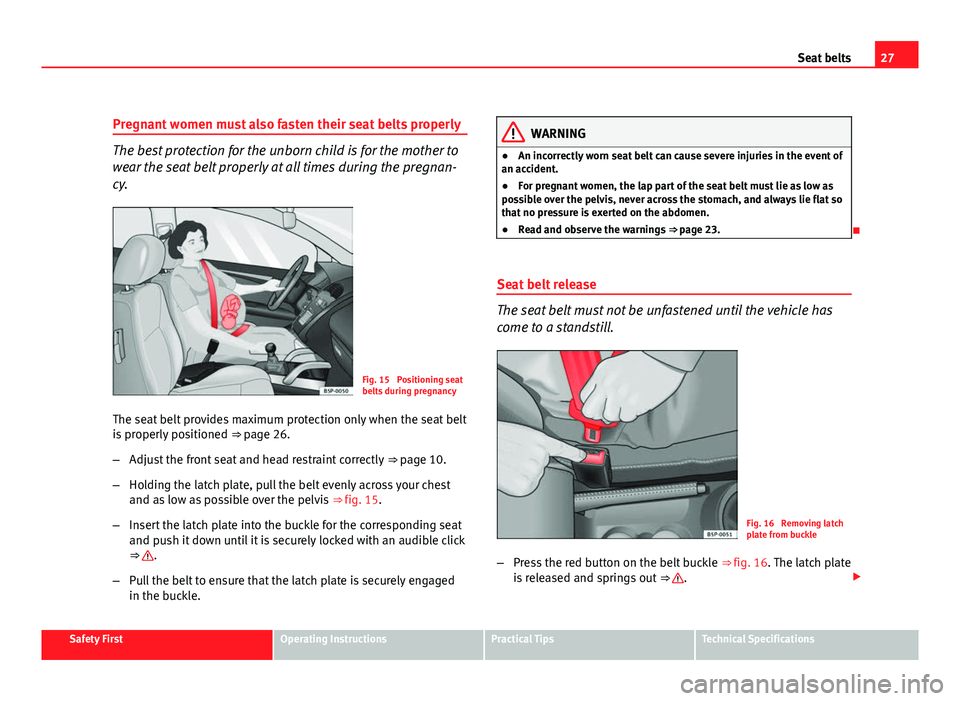
27
Seat belts
Pregnant women must also fasten their seat belts properly
The best protection for the unborn child is for the mother to
wear the seat belt properly at all times during the pregnan-
cy.
Fig. 15 Positioning seat
belts during pregnancy
The seat belt provides maximum protection only when the seat belt
is properly positioned ⇒ page 26.
– Adjust the front seat and head restraint correctly ⇒ page 10.
– Holding the latch plate, pull the belt evenly across your chest
and as low as possible over the pelvis ⇒ fig. 15.
– Insert the latch plate into the buckle for the corresponding seat
and push it down until it is securely locked with an audible click
⇒
.
– Pull the belt to ensure that the latch plate is securely engaged
in the buckle.
WARNING
● An incorrectly worn seat belt can cause severe injuries in the event of
an accident.
● For pregnant women, the lap part of the seat belt must lie as low as
possible over the pelvis, never across the stomach, and always lie flat so
that no pressure is exerted on the abdomen.
● Read and observe the warnings ⇒ page 23.
Seat belt release
The seat belt must not be unfastened until the vehicle has
come to a standstill.
Fig. 16 Removing latch
plate from buckle
– Press the red button on the belt buckle ⇒ fig. 16. The latch plate
is released and springs out ⇒
.
Safety FirstOperating InstructionsPractical TipsTechnical Specifications
Page 30 of 297

28Seat belts
–Guide the belt back by hand so that it rolls up easily and the
trim is not damaged
WARNING
Never unbuckle a seat belt while the vehicle is in motion. If you do, you
increase the risk of sustaining severe or fatal injuries.
Adjusting the seat belt height
Seat belt height adjusters can be used to adjust the position
of the seat belt at the shoulder.
Fig. 17 Location of the
belt height adjuster
The seat belt adjuster for the front seats can be used to adjust the
proper belt position at the shoulder.
– Press the upper part of the shoulder belt guide and hold it in
this position ⇒ fig. 17. –
Move the shoulder belt guide up or down until you have adjus-
ted the seat belt ⇒ page 26.
– After adjusting, pull the shoulder belt sharply to check that the
catch on the shoulder belt guide is engaged securely.
Incorrectly fastened seat belts
Incorrectly worn seat belts can cause severe or even mortal
injuries. Seat belts can provide optimal protection only if the belt web is
properly worn. The seat belts must be fastened exactly in the order
described in this chapter. An incorrect sitting position impairs sub-
stantially the protection a seat belt offers and can lead to severe or
fatal injuries. The risk of severe or fatal injuries is especially in-
creased when a deploying airbag strikes an occupant who has as-
sumed an incorrect sitting position. As the driver, you are responsi-
ble for all vehicle occupants, especially children. Therefore:
– Never allow anyone to wear the seat belt incorrectly while the
vehicle is moving ⇒
.
WARNING
● An incorrectly worn seat belt increases the risk of severe injuries.
● Before every trip, instruct your passengers to adjust their seat belts
properly and to wear them for the whole journey.
● Read and always observe information and warnings concerning the
use of seat belts ⇒ page 23.
Page 47 of 297

45
Airbag system
WARNING
● The driver is responsible for the proper position of the key-operated
switch.
● You should deactivate the front passenger airbag only if you have to
use a rear-facing child seat in exceptional cases. ⇒ page 46, Child safe-
ty.
● Never install a child seat facing backwards on the front passenger
seat unless the front passenger airbag has been disabled. Otherwise,
there is a risk of death. If under exceptional circumstances it is necessary
to transport a child in a rear-facing child seat on the front passenger
seat, you must always disable the front passenger airbag.
● As soon as the child seat is no longer needed on the front passenger
seat, enable the front passenger airbag again.
● Only deactivate the passenger airbag when the ignition is off, other-
wise a fault may occur in the airbag system, which could cause the airbag
to not deploy properly or not deploy at all.
● When the passenger airbag is deactivated, if the warning lamp AIR-
BAG OFF is not continuously lit up, there may be a fault in the airbag sys-
tem:
–Have the airbag system inspected immediately by a specialised
workshop.
– Do not use a child seat on the front passenger seat! The front pas-
senger airbag could be triggered despite the fact that there is a fault
in the system and, as a result, a child could sustain serious or fatal
injuries.
– It is unpredictable whether the front passenger airbag will deploy
in the event of an accident. Warn all your passengers of this.
● When using the ignition key to activate/deactivate the front passen-
ger airbag, only the front passenger airbag will be activated/deactivated.
The side airbag and head airbag on the passenger side will remain ac-
tive.
Safety FirstOperating InstructionsPractical TipsTechnical Specifications